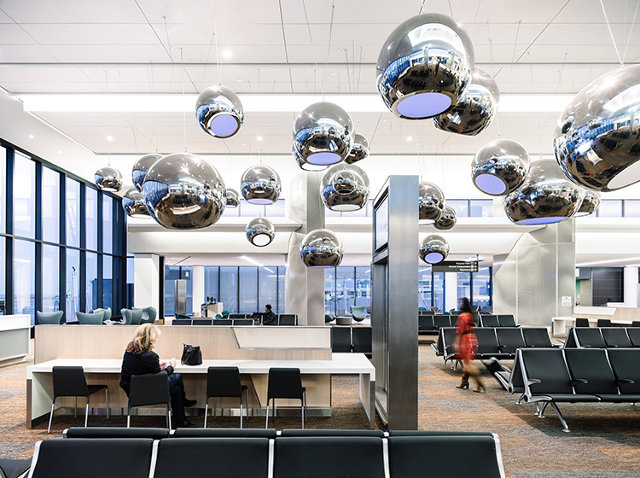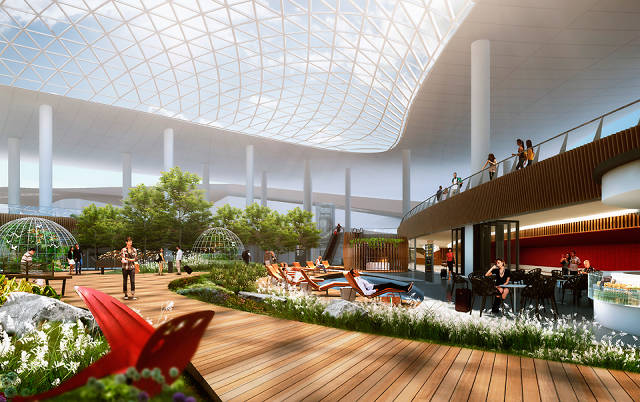Our Future Departure
Posted June 11, 2014

What is the future of the airport? Theorists and designers have been contemplating and presenting an elevated level of air travel for a number of years. When air travel began it was associated with a special type of luxury, despite the smoking in the friendly skies (Here is Marketplace report to say so). But today, in a post 9/11 world, flying is the opposite of convenience and elegance. Heightened security, disgusting facilities, rude people, and a general panic that overtakes every passenger is the norm. We enter an airport and hurry up and wait.
Luckily, there are projects and ideas at the forefront of airport design modernizing and refreshing these spaces. With the goal of making the air travel experience passenger friendly by creating new environments and experiences in the terminals we pass through, the future of airports is starting to look a lot more pleasurable.
Why is design in airports an important issue? Because there is competition in the experiences. Airports are vying for passenger and airline business. A more pleasant experience will help the airport stay attractive and relevant to the business and tourist populations that pass through its gates. But, there is a second and third aspect to a well-designed airport terminal: branding and sales. A quick survey of a couple of examples of airport terminals that will or have been redesigned to meet modern requirements will help to uncover how passenger comfort, branding, and sales are coming together.
A recent redesign of San Francisco International’s Terminal 3 is a great example of an American airport leading the way towards a new passenger experience. Gensler Architects designed the changes in the terminal and its features are there to provide a healthy, calming experience for travelers and airport employees. When was the last time that you traveled through an airport and felt comfortable?
The new SFO terminal features unobstructed sight lines granted by and elevated, scenic overlook into the terminal. Raised ceilings and an entryway that grants a perspective over the interior reduces visitors’ feeling of being lost. Not knowing which way to go is a constant stress in an airport. In Terminal 3, a traveler will know how the concourse is laid out upon arrival. That knowledge of where and how is extremely important and prevents a significant amount of stress for the visitor, opening up opportunity for other experiences. It could be said that the lack of stress opens up the space for travel.
The terminal also features four restaurants, eight stores, and pop-up shops that add a touch of neighborhood to the design. The daylight infused area, neither too bright nor too dim, and not overly lit by halogen light messes, provides a natural, outdoor/indoor feel that increases ease and relaxation. The electric lighting that is present is programmed to correspond to people’s natural circadian rhythms, and thus does not seem odd or out of pace with our sleeping and waking. It will be much easier to catch a few Zs while waiting for that all-nighter in this terminal.
The purpose of this design is to make the traveler feel better. But beyond the aesthetic changes, there are two other aspects of airports that design enhances.
An airport is the first brand ambassador for a city. When travelers land in a new city the first area they are greeted by is the airport. We have all said at one point, “I’ve been to the airport in [insert city].” We learn about the nature of a place by the spaces we pass through to get there. Think back on the last experience you had at an airport. When you disembarked from the plane, was it refreshing? Was the space inviting? Was it relaxing? Was it exciting? For the most part, and especially in the United States, the experience was probably something to hurry through.
The importance of these arrival places are not lost in other parts of the world. An example is the Incheon International Airport in South Korea, which is a sign of luxury upon entering the country. The airport is already a shopping destination, with some of the biggest brands in the world featured in the terminals. A new redesign in the future will add natural gardens, butterfly enclosures, live performance spaces, and further luxurious shopping for the international traveler, and surprisingly, the citizens of Seoul. Upon entering Seoul, visitors will be transported into a verdant landscape and luxurious setting. That is a powerful brand statement.

In Munich, the airport has a brewery, a beer garden, and an Audi Showroom. These features showcase trademark attributes of the country. It is the entryway into a new way of life and thinking. Airports are in a unique position to impart this experience. That leads to the third attribute of a well-designed airport terminal mentioned above: Sales.
Terminals are places where concessions happen. Everyone wants a coffee, sandwich, snack, juice, or any combination there of. Concessions account for a large portion of the airports operating costs, and an increase in sales reduces the amount airlines have to pay to keep the terminal open. Writing in Fast Company, Bill Hooper of Gensler stated, “Aspirational airports—those that have mastered the art of distracting and ultimately luring travelers—have the potential to make big money…An airport’s lively concession program can and has eased the airlines’ burden of airport operating costs. Airlines used to pay some 70% of those airport costs and now shoulder only about 40% of that burden largely because concession programs have been ramped up.”
Increased sales are driven by relaxed and engaged travelers that have the time, energy, and space to make purchases. A weary business traveler wants to take some time over a meal before a flight. A tourist wants to grab that last souvenir before boarding. An airport can be a shopping destination, as in the case of Seoul. But if these travelers are frantic, pressed, uninspired, no sales will take place and the business of the airport will be reduced.
Redesigning airports is experience design. The spaces, flow, information architecture, and geography of the space should all lead to the added comfort and ease of the traveler and an enhanced ability of the people who work there. The parts should work together to create a greater whole that evolves and reacts to the users that experience the place on a daily basis, be they workers or travelers. The lasting effect of creating a pleasurable space is akin to creating a community like environment. In communities, the good done for one person is passed on to the other members. In an airport, happy travelers lead to happy workers lead to happy travelers.
The airports of the future will be places of ease and excitement, that allow the traveler to take off towards their destination without the added baggage of a horrible experience. Airports will be the brand ambassadors and places of commerce that they have the potential to be. In a world where 5 billion people move through the world’s airports each year, all these important spaces deserve better design.
***
(Information on Gensler’s designs from: The Airport Of The Future Will Relax You, Instead Of Stressing You Nearly To Death, Pat Askew and Tama Duffy Day; The Airport Of The Future Is About More Than Takeoff And Landing, Bill Hooper)


Join The Conversation